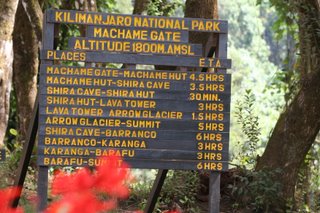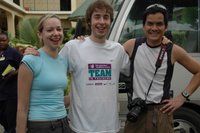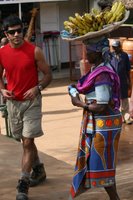
[Pictures: Top, Our Guide (Chief Interpreter), Bruce; Bottom, one of our assistant guides, Living]
In the evening before we started the Kilimanjaro trek we met our guide, Bruce Lawrence, and one of our two assistant guides, Living Thomas, for the first time. The guide issue was a bit sticky from the start. As part of the pre-trip planning, Ajay worked to ensure that whoever our guide was, that person had the status of Chief Interpreter (see below), the highest designation for a guide. Shortly before we left the United States, the guide that was suppose to lead us had some problems with the Tanzanian park service, the details of which we were not privy to. Our replacement was Bruce, who fortunately was also a Chief Interpreter. However, on our first meeting, it was Living who greeted us, who happend to be Bruce's half brother. Living informed us that because of a personal issue in their family, Bruce would not be able to join us, and that he would be the one to

lead our expedition. Although the rest of us just shrugged our shoulders, fortunately for us, Ajay realized the importance of having a Chief Interpreter and was more persistent. After speaking with Zainab, the owner of Zara, things ultimately worked out that Bruce was able to join us. This turned out to be an important detail, because although Living, the assistent guide, proved to be quite capable, Bruce's knowledge and experience on the mountain proved to be a tremendous benefit for us from an educational standpoint.
Ultimately our team consisted of 14 members plus the 4 of us: 8 porters, a cook, a server/waiter, a tent person, our guide and two assistant guides (Hamasi Omari was the other assistant guide, who we met the next day). It's unclear why we had two assistant guides, since we were a small group, but that's the way it was. It seemed as if this was quite a large party for just 4 trekkers, but I'm pretty sure that recently the park service passed a requirement that there be a certain number of porters per trekker. Most of the porters are hired by the tour company, but a certain percentage (25% I believe) must be taken from a pool of potential individuals queued up at the entrance gate to the mountain. This is an effort to provide employment to locals.
"Kilimanjaro: a Trekking Guide to Africa's Highest Mountain" by Henry Stedman is currently the best resource in print for preparing for a Kilimanjaro trip. In this book, Stedman discusses the various levels and skills of the members of the trekking team. The job of the porters is essentially to get all the gear, food, etc. from camp to camp. They accompany the trekkers to the last camp, but do not join in the final summit push. The next step above the porter is the assistant guide, an individual hoping to eventually achieve the status of guide. An assistant guide starts as a porter, but in being promoted begins to gain the responsibilities of the guides themselves. They must accompany the trekkers to the summit, and as was the case of our assistant guides, many begin to learn the details of the mountain in terms of understanding is geology, flora, fauna, as well as understanding how to care for their clients in the harsh environment and high altitude. Finally, there is the guide who has obtained a license after undergoing extensive training by the park authorities. They must pass a course where they demonstrate mastery of the essentials that I mentioned above, plus do extensive touring on all the routes leading to the summit of Kilimanjaro. Despite this, the quality of the guides vary. The Park system is attempting to further categorize guides according to their skills and knowledge. At the bottom would be the Route Guide, one that knows the basics of leading the way up the mountain, understands basic cooking, etc., to the Chief Interpreter, who has demonstrated clear mastery of all aspects of the mountain. For example, Bruce, our Chief Interpreter truely had a love of the mountain itself as well as learning skills that would help him better serve his clients. In addition to the required classes for guides in flora, fauna, geology, in the off season Bruce would take classes to learn English, German, etc. He was an invaluable part of our experience. Not to be overlooked is the fact that you have a person with you who has the skills necessary to take care of you if you are unfortunate enough to succuum to severe illness or injury. That's not to take anything away from our assistant guides, Living and Hamasi, who's attentiveness to our group on the final summit push was appreciated by all of us.
For trekkers just wanting to get to the summit and back with little regard to anything else, a Route Guide would probably suffice. On the other hand, anyone who wants to really understand the essence of the mountain they are climbing a Chief Interpreter is highly recommended... I would not go without one. Much of what I hope to tell you about in this blog was built on the information provided to me by Bruce.


















